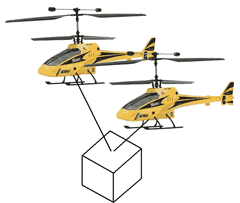Supervisor: Glenn R. Heppler
Background
Helicopters are often used in military operations and construction work to airlift and transport heavy objects. Its ability to hover in one place makes it superior to regular fixed-wing aircraft in performing such tasks as positioning large transmission towers during assembly or carrying large tanks into remote and dangerous locations. However, despite the versatility and strength of a helicopter such as the CH-47 Chinook, there are limitations to its lifting capacity and manoeuvrability. To stabilize a helicopter, many controls must be operated at once. Even the relatively simple task of hovering requires constant adjustment to pitch, roll, yaw and heave. This makes it difficult to have more than one helicopter fly in formation as can be done with fixed-wing airplanes. If two or more helicopters were able to combine their efforts to carrying a common payload of a much greater size, then many military and industrial problems would be resolved. However, to perform such a feat would put the pilots' lives at risk. In addition to manning their own aircraft, the pilots would also have to take into account the positions of neighbouring helicopters as well as deal with the complicated aerodynamics resulting from close proximity flight.
Other existing technologies and patents have attempted to address this design issue by introducing a spreader bar or truss system that holds the aircraft at fixed distances from each other, thereby preventing collisions. However, the mechanical linkages tightly couple the helicopters, such that the failure of one helicopter causes the entire lifting system to fail. Our autonomous swarm control system is a novel solution that allows individual helicopters to fly in formation and transport heavy loads with greatly reduced coupling. Moreover, our semi-autonomous system would allow a single pilot to control the swarm remotely and from a safe environment.
Project description
To achieve greater lifting capacity required to deliver a single payload, a system that can coordinate multiple helicopters in a flexible, robust and effective way is needed.

A control system that allows two RC helicopters to hover autonomously with a common payload tethered beneath shall be designed. The Blade CX model R/C helicopter has been chosen as the platform for the prototype. The payload shall be centred between the helicopters and attached using cables. The ultimate goal is to design a controller that could be extended to a swarm of several helicopters and enable the transport of a tethered payload from one point to another.
Design methodology
The project is divided into the three main areas: systems modelling, control design, and electrical implementation. The model to be developed encompasses both the flight dynamics of a single Blade CX helicopter and the interactions of two helicopters with an attached payload. Using this plant model, the control system shall be designed to operate multiple helicopters simultaneously while maintaining stability of the individual helicopters and the swarm as a whole. The positions and orientations of the each helicopter shall be controlled to compensate for the disturbances of the payload and adverse aerodynamics. Accelerometers and gyroscopes will be placed on each helicopter to provide feedback to the control system. The following is a breakdown of the required theories and equipment that will be used to complete the design project.
Modelling:
- Experimental and black-box method
- Analytical and graph theoretical method
Controller:
- Discrete linear quadratic regulator
- Multi-variate state feedback methods
Electrical implementation:
- SPI Protocol
- 8051 Microprocessors
- Digital logic and analog circuits